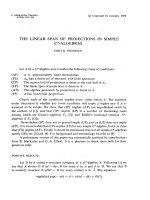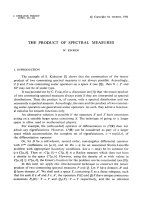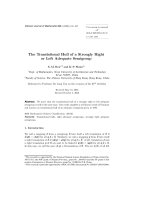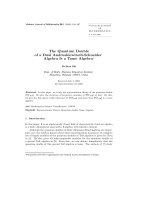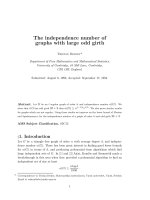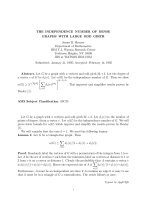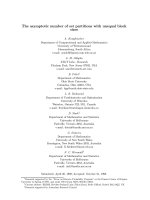Báo cáo toán học: "The Fundamental Group of Balanced Simplicial Complexes and Posets" potx
Bạn đang xem bản rút gọn của tài liệu. Xem và tải ngay bản đầy đủ của tài liệu tại đây (142.21 KB, 12 trang )
The Fundamental Group of Balanced Simplicial
Complexes and Posets
Steven Klee
Department of Mathematics, Box 354350
University of Washington, Seattle, WA 98195-4350, USA,
Submitted: Sep 29, 2008; Accepted : Apr 18, 2009; Published: Apr 27, 2009
Mathematics S ubject Classifications: 05E25, 06A07, 55U10
Dedicated to Anders Bj¨orner on the occasion of his 60th birthday
Abstract
We establish an upper bound on the cardinality of a minimal generating set for
the fundamental group of a large family of connected, balanced simplicial complexes
and, more generally, simplicial posets.
1 Introduction
One commonly studied combinatorial invariant of a finite (d − 1)-dimensional simplicial
complex ∆ is its f-vector f = (f
0
, . . . , f
d−1
) where f
i
denotes the number of i-dimensional
faces of ∆. This leads to the study of the h-numbers of ∆ defined by the relation
d
i=0
h
i
λ
d−i
=
d
i=0
f
i−1
(λ − 1)
d−i
. A great deal of work has been done to relate the
f-numbers and h-numbers of ∆ to the dimensions of the singular homology groups of
∆ with coefficients in a certain field; see, for example, the work of Bj¨orner and Kalai
in [2] and [3], and Chapters 2 and 3 of Stanley [13]. In comparison, very little seems
to be known a bout the relationship between the f-numbers of a simplicial complex and
various invariants of its homotopy groups. In this paper, we bound the minimal number
of generators of the fundamental group of a balanced simplicial complex in terms of h
2
.
More generally, we bound the minimal number of generators of the fundamental group of
a balanced simplicial poset in terms of h
2
.
It was conjectured by Kalai [7] and proved by Novik and Swartz in [8] that if ∆ is a
(d − 1)-dimensional manifold that is orientable over the field k, then
h
2
− h
1
≥
d + 1
2
β
1
,
where β
1
is the dimension of the singular homology group H
1
(∆; k). The Hurewicz The-
orem (see Spanier [10]) says that H
1
(X; Z) is isomorphic to the abelianization of π
1
(X, ∗)
the electronic journal of combinatorics 16(2) (2009), #R7 1
for a connected space X. We will see below t hat π
1
(∆, ∗) is finitely generated. Thus
the Hurewicz Theorem says that the minimal number of generators of the fundamental
group of a simplicial complex ∆ is gr eater than or equal to the number of generators of
H
1
(∆; Z). By the universal coefficient theorem, H
1
(∆; k) ≈ H
1
(∆; Z) ⊗ k for any field k;
and, consequently, the minimal number of generators of π
1
(∆, ∗) is greater than or equal
to β
1
(∆) for any field k.
In this paper, we study simplicial complexes and simplicial posets ∆ that are pure and
balanced with the property that every face F ∈ ∆ of codimension at least 2 (including
the empty face) has connected link. This includes the class of balanced triangulations of
compact manifolds and, using the language of Goresky and MacPherson in [5], the more
general class of balanced normal pseudomanifolds. Under these weaker assumptions, we
show that
h
2
≥
d
2
m(∆),
where m(∆) denotes the minimal number of generators o f π
1
(∆, ∗).
The paper is structured as follows. Section 2 contains all necessary definitions and
background material. In Section 3, we outline a sequence of theorems in algebraic topology
that are used to give a description of the fundamental group in terms of a finite set of
generators and relations. In Section 4, we use the theorems in Section 3 to prove Theorem
4.5. This theorem gives the desired bound on m(∆). In Section 5, a fter giving some
definitions related to simplicial posets, we extend the topological results in Section 3 and
the result of Theorem 4.5 to the class of simplicial posets.
2 Notation and Convention s
Throughout this paper, we assume that ∆ is a (d − 1)-dimensional simplicial complex on
vertex set V = {v
1
, . . . , v
n
}. We recall that the dimension of a face F ∈ ∆ is dim F =
|F | − 1, and the dimension of ∆ is dim ∆ = max{ dim F : F ∈ ∆}. A simplicial complex
is pure if all of its facets (maximal faces) have the same dimension. The link of a face
F ∈ ∆ is the subcomplex
lk
∆
F = {G ∈ ∆ : F ∩ G = ∅, F ∪ G ∈ ∆}.
Similarly, the closed star of a fa ce F ∈ ∆ is the subcomplex
st
∆
F = {G ∈ ∆ : F ∪ G ∈ ∆}.
The geometric realization of ∆, denoted by |∆|, is the union over all faces F ∈ ∆ of
the convex hull in R
n
of {e
i
: v
i
∈ F } where {e
1
, . . . , e
n
} denotes the standard basis in R
n
.
Given this geometric realization, we will make little distinction between the combinatorial
object ∆ and the topological space |∆|. For example, we will o ften abuse notation and
write H
i
(∆; k) instead of the more cluttered H
i
(|∆|; k).
The f-vector of ∆ is the vector f = (f
−1
, f
0
, f
1
, . . . , f
d−1
) where f
i
denotes the number
of i-dimensional faces of ∆. By convention, we set f
−1
= 1, corresponding to the empty
the electronic journal of combinatorics 16(2) (2009), #R7 2
face. If it is important to distinguish the simplicial complex ∆, we write f(∆) for the
f-vector of ∆, and f
i
(∆) for its f-numbers (i.e. the entries of its f-vector). Another
important combinatorial invariant of ∆ is the h-vector h = (h
0
, . . . , h
d
) where
h
i
=
i
j=0
(−1)
i−j
d − j
d − i
f
j−1
.
For us, it will be particularly important to study a certain class of complexes known
as balanced simplicial complexes, which were introduced by Stanley in [11].
Definition 2.1 A (d−1)-dimensional si mplicial complex ∆ is balanced if its 1-skeleton,
considered as a graph, is d-colorable. That is to say there is a coloring κ : V → [d] such
that fo r all F ∈ ∆ and distinct v, w ∈ F, we have κ(v) = κ(w). We assume that a
balanced complex ∆ comes equipped with such a coloring κ.
The order complex of a rank-d graded poset is one example of a balanced simplicial
complex. If ∆ is a balanced complex and S ⊆ [d], it is often import ant to study the
S-rank selected subcomplex of ∆, which is defined as
∆
S
= {F ∈ ∆ : κ(F ) ⊆ S};
that is, for a fixed coloring κ, we define ∆
S
to be the subcomplex of faces whose vertices
are colored with colors from S. In [11] Stanley showed that
h
i
(∆) =
|S|=i
h
i
(∆
S
). (1)
3 The Edge-Path Group
In order to obtain a concrete description of π
1
(∆, ∗) that relies only on the structure of ∆
as a simplicial complex, we introduce the edge-path group of ∆ (see, for example, Seifert
and Threlfall [9 ] or Spanier [10]). This will ultimately allow us to relate the combinatorial
data of f(∆) to the fundamental group of ∆.
An edge in ∆ is an ordered pair of vertices (v, v
′
) with {v, v
′
} ∈ ∆. An edge path γ in
∆ is a finite nonempty sequence (v
0
, v
1
)(v
1
, v
2
) · · · (v
r−1
, v
r
) of edges in ∆. We say that γ
is an edge path from v
0
to v
r
, or that γ starts at v
0
and ends at v
r
. A closed edge path
at v is an edge path γ such that v
0
= v = v
r
.
We say that two edge paths γ and γ
′
are simply equivalen t if there exist vertices
v, v
′
, v
′′
in ∆ with {v, v
′
, v
′′
} ∈ ∆ such that the unordered pair { γ, γ
′
} is equal to one of
the following unordered pairs:
• {(v, v
′′
), (v, v
′
)(v
′
, v
′′
)},
• {γ
1
(v, v
′′
), γ
1
(v, v
′
)(v
′
, v
′′
)} for some edge path γ
1
ending at v,
the electronic journal of combinatorics 16(2) (2009), #R7 3
• {(v, v
′′
)γ
2
, (v, v
′
)(v
′
, v
′′
)γ
2
} for some edge path γ
2
starting at v
′′
,
• {γ
1
(v, v
′′
)γ
2
, γ
1
(v, v
′
)(v
′
, v
′′
)γ
2
} for edge paths γ
1
, γ
2
as above.
We note that the given vertices v, v
′
, v
′′
∈ ∆ need not be distinct. For example,
(v, v) is a valid edge (the edge that does not leave the vertex v), and we have the simple
equivalence (v, v
′
)(v
′
, v) ∼ (v, v). We say that two edge paths γ and γ
′
are equivalent, and
write γ ∼ γ
′
, if there is a finite sequence of edge paths γ
0
, γ
1
, . . . , γ
s
such that γ = γ
0
,
γ
′
= γ
s
and γ
i
is simply equivalent to γ
i+1
for 0 ≤ i ≤ s − 1. It is easy to check that this
defines an equivalence relation on the collection of edge paths γ in ∆ starting at v and
ending at v
′
. Moreover, for two edge paths γ and γ
′
with the terminal vertex of γ equal
to the initial vertex of γ
′
, we can form their product edge path γγ
′
by concatenation.
Now we pick a base vertex v
0
∈ ∆. Let E(∆, v
0
) denote the set of equivalence classes
of closed edge paths in ∆ based at v
0
. We multiply equivalence classes by [γ] ∗ [γ
′
] = [γγ
′
]
to give E(∆, v
0
) a group structure called the edge path group of ∆ based at v
0
.
The Cellular Approximation Theorem ([10] VII.6.1 7) tells us that any path in ∆ is
homotopic to a path in the 1-skeleton of ∆. We use this fact to motivate the proof of the
following theorem f rom Spanier.
Theorem 3.1 ([10] III.6.17) If ∆ is a simplicial complex and v
0
∈ ∆, then there is a
natural iso morphism
E(∆, v
0
) ≈ π
1
(∆, v
0
).
For a connected simplicial complex ∆ we will also consider the group G, defined as
follows. Let T be a spanning tree in the 1-skeleton of ∆. Since ∆ is connected, such a
spanning tree exists. We define G to be the free group generated by edges (v, v
′
) ∈ ∆
modulo the relations
[R1]. (v, v
′
) = 1 if (v, v
′
) ∈ T , and
[R2]. (v, v
′
)(v
′
, v
′′
) = (v, v
′′
) if {v, v
′
, v
′′
} ∈ ∆.
The following theorem will be crucial in our study of the fundamental group.
Theorem 3.2 ([10] III.7.3) With the above notation,
E(∆, v
0
) ≈ G.
We note for later use that this isomorphism is given by the map
Φ : E(∆, v
0
) → G
that sends [(v
0
, v
1
)(v
1
, v
2
) · · · (v
r−1
, v
r
)]
E
→ [(v
0
, v
1
)(v
1
, v
2
) · · · (v
r−1
, v
r
)]
G
. Here, [−]
E
and
[−]
G
denote the equivalence classes of an edge path in E(∆, v
0
) and G, respectively. The
inverse to this map is defined on the generators of G as follows. For (v, v
′
) ∈ ∆, there is
an edge path γ from v
0
to v along T and an edge path γ
′
from v
′
to v
0
along T . Using
these paths, we map Φ
−1
[(v, v
′
)]
G
= [γ(v, v
′
)γ
′
]
E
.
the electronic journal of combinatorics 16(2) (2009), #R7 4
4 The Fundamental Group and h-numbers
Our goal now is to use Theorem 3.2 to bound the minimal number of generators of
π
1
(∆, ∗). For ease of notation, let m(∆, ∗) denote the minimal number of generators of
π
1
(∆, ∗). When the basepoint is understood or irrelevant (e.g. when ∆ is connected)
we will write m(∆) in place of m(∆, ∗). For the remainder of this section, we will be
concerned with simplicial complexes ∆ of dimension (d −1) with the following properties:
(I). ∆ is pure,
(II). ∆ is balanced,
(III). lk
∆
F is connected for all f aces F ∈ ∆ with 0 ≤ | F | < d − 1.
In particular, property (III) implies that ∆ is connected by taking F to be the empty
face.
Since results on balanced simplicial complexes are well-suited to proofs by induction,
we begin with the following observation.
Proposition 4.1 Let ∆ be a simplicial complex with d ≥ 2 that satisfies p roperties (I) –
(III). If F ∈ ∆ is a face with |F | < d − 1, then lk
∆
F satisfies properties (I)–(III) as
well.
Proof: When d = 2, the result holds trivially since the only such face F is the empty
face. When d > 3 and F is nonempty, it is sufficient to show tha t the result holds for a
single vertex v ∈ F . Indeed, if we set G = F \ {v}, then lk
∆
F = lk
lk
∆
v
G at which point
we may appeal to induction on |F |.
We immediately see that lk
∆
v inherits properties (I) and (II) from ∆. Finally, if
σ ∈ lk
∆
v is a face with |σ| < d − 2, then lk
lk
∆
v
σ = lk
∆
(σ ∪ v) is connected by property
(III).
Lemma 4.2 Let ∆ be a (d − 1)-dimensional simplicial complex with d ≥ 2 that satisfies
properties (I) and (I II). If F and F
′
are facets in ∆, then there is a chain of f acets
F = F
0
, F
1
, . . . , F
m
= F
′
(∗)
such that |F
i
∩ F
i+1
| = d − 1 for all i.
Remark 4.3 We say that a pure simplicial complex satisfying property ( *) is strongly
connected.
Proof: We proceed by induction on d. When d = 2, ∆ is a connected graph, and such
a chain of facets is a path fr om some vertex v ∈ F to a vertex v
′
∈ F
′
. We now assume
that d ≥ 3.
First, we note that the closed star of each face in ∆ is strongly connected. Indeed, by
induction the link (and hence the closed star st
∆
σ) o f each f ace σ ∈ ∆ with |σ| < d − 1
the electronic journal of combinatorics 16(2) (2009), #R7 5
is strongly connected. On the ot her hand, if σ ∈ ∆ is a face with |σ| = d − 1, then every
facet in st
∆
σ contains σ and so st
∆
σ is strongly connected as well. Finally, if σ is a facet,
then st
∆
σ is strongly connected as it only contains a single facet.
It is also clear that if ∆
′
and ∆
′′
are strongly connected subcomplexes of ∆ such that
∆
′
∩ ∆
′′
contains a facet, then ∆
′
∪ ∆
′′
is strongly connected as well. Finally, supp ose
∆
0
⊆ ∆ is a maximal strongly connected subcomplex of ∆. If F ∈ ∆
0
is any face, then
st
∆
F intersects ∆
0
in a facet. Since st
∆
F ∪ ∆
0
is strongly connected a nd ∆
0
is maximal,
we must have st
∆
F ⊆ ∆
0
. Thus ∆
0
is a connected component of ∆. Since ∆ is connected,
∆ = ∆
0
.
Lemma 4.4 Let ∆ be a (d − 1)-dimensional simplicial complex with d ≥ 2 that satisfies
properties (I)–(III). For any S ⊆ [d] with |S| = 2, the rank selected subcomplex ∆
S
is
connected.
Proof: Say S = {c
1
, c
2
}. Pick vertices v, v
′
∈ ∆
S
and facets F ∋ v, F
′
∋ v
′
. By
Lemma 4.2, there is a chain of facets F = F
1
, . . . , F
m
= F
′
for which F
i
intersects F
i+1
in
a codimension 1 face. We claim that a path from v to v
′
in ∆
S
can be found in ∪
m
i=1
F
i
.
When m = 1 , {v, v
′
} is an edge in F = F
1
= F
′
. For m > 1, we examine the facet F
1
.
Without loss of generality, say κ(v) = c
1
, and let w ∈ F
1
be the vertex with κ(w) = c
2
. If
{v, w} ∈ F
1
∩ F
2
, then the facet F
1
in our chain is extraneous, and we could have taken
F = F
2
instead. Inductively, we can find a path from v to v
′
in ∆
S
that is contained in
∪
m
i=2
F
i
. On the other hand, if v /∈ F
2
, then we can find a path from w to v
′
in ∆
S
that is
contained in ∪
m
i=2
F
i
by induction. Since (v, w) ∈ ∆
S
, this path extends to a path from v
to v
′
in ∆
S
.
Theorem 4.5 Let ∆ be a (d − 1)-dimensio nal si mplicial complex with d ≥ 2 that satisfies
properties (I)–(III) , and S ⊆ [d ] with |S| = 2. If v, v
′
are vertices in ∆
S
, then any edge
path γ from v to v
′
in ∆ is equivalent to an edge path from v to v
′
in ∆
S
.
Proof: When d = 2, ∆
S
= ∆, and the result holds trivially, so we can assume d ≥ 3.
We may write our edge path γ as a sequence
γ = (v
0
, v
1
)(v
1
, v
2
) · · · (v
r−1
, v
r
)
where v
0
= v, v
r
= v
′
, and {v
i
, v
i+1
} ∈ ∆ for all i. We establish the claim by induction
on r. When r = 1, the edge (v , v
′
) is already an edge in ∆
S
. Now we assume r > 1. If
v
1
∈ ∆
S
, the sequence (v
1
, v
2
) · · · (v
r−1
, v
r
) is equivalent to an edge path γ from v
1
to v
′
in ∆
S
by our induction hypothesis on r. Hence γ is equivalent to (v
0
, v
1
)γ.
On the other hand, suppose that v
1
/∈ ∆
S
. Since κ(v
1
) /∈ S and ∆ is pure and
balanced, there is a vertex v ∈ ∆
S
such that {v
1
, v
2
, v} ∈ ∆. By Proposition 4.1, lk
∆
v
1
is a simplicial complex of dimension at least 1 satisfying properties (I)–(III). Thus by
Lemma 4.4, there is an edge path γ
′
= (u
0
, u
1
) · · · (u
k−1
, u
k
) such that u
0
= v
0
, u
k
= v,
and each edge {u
i
, u
i+1
} ∈ (lk
∆
v
1
)
S
. Since each edge {u
i
, u
i+1
} ∈ lk
∆
v
1
, it follows that
{u
i
, u
i+1
, v
1
} ∈ ∆ for all i.
the electronic journal of combinatorics 16(2) (2009), #R7 6
We now use the fact that (u, u
′
)(u
′
, u
′′
) ∼ (u, u
′′
) for all {u, u
′
, u
′′
} ∈ ∆ to see the
following simple equivalences of edge paths.
(v
0
, v
1
)(v
1
, v) = (u
0
, v
1
)(v
1
, v)
∼ (u
0
, u
1
)(u
1
, v
1
)(v
1
, v)
∼ (u
0
, u
1
)(u
1
, u
2
)(u
2
, v
1
)(v
1
, v)
. . .
∼ (u
0
, u
1
)(u
1
, u
2
) · · · (u
k−2
, u
k−1
)(u
k−1
, v
1
)(v
1
, v)
∼ (u
0
, u
1
)(u
1
, u
2
) · · · (u
k−2
, u
k−1
)(u
k−1
, v).
For convenience, we write γ
1
= (u
0
, u
1
)(u
1
, u
2
) · · · (u
k−2
, u
k−1
)(u
k−1
, v). Now we ob-
serve that (v
0
, v
1
)(v
1
, v
2
) ∼ (v
0
, v
1
)(v
1
, v)(v, v
2
) so that
γ = (v
0
, v
1
)(v
1
, v
2
)(v
2
, v
3
) · · · (v
r−1
, v
r
)
∼ (v
0
, v
1
)(v
1
, v)(v, v
2
)(v
2
, v
3
) · · · (v
r−1
, v
r
)
∼ γ
1
(v, v
2
)(v
2
, v
3
) · · · (v
r−1
, v
r
).
By induction on r , there is an edge path γ
2
in ∆
S
from v to v
r
that is equiva lent to
(v, v
2
)(v
2
, v
3
) · · · (v
r−1
, v
r
) so that γ ∼ γ
1
γ
2
. Thus, indeed, γ is equivalent to an edge path
in ∆
S
.
Setting v = v
′
= v
0
, we have the following corollary.
Corollary 4.6 If v
0
∈ ∆
S
, ev ery class in E(∆, v
0
) can be represented by a closed edge
path in ∆
S
.
Now we have an explicit description of a smaller generating set of π
1
(∆, v
0
).
Lemma 4.7 Let ∆ be a (d − 1)-dimensional simplicial complex with d ≥ 2 that satisfies
properties ( I)–(III). For a fixed S ⊆ [d] with | S| = 2, the group G of Th eorem 3.2 is
generated by the edges (v, v
′
) with {v, v
′
} ∈ ∆
S
.
Proof: In order to use Theorem 3.2, we must choose some spanning tree T in the 1-
skeleton of ∆. We will do t his in a specific way. Since ∆
S
is a connected graph, we can
find a spanning tree
T in ∆
S
. Since ∆ is connected, we can extend
T to a spanning tree
T in ∆ so that
T ⊆ T.
By Corollary 4.6, each class in E(∆, v
0
) is represented by a closed edge path in ∆
S
,
and hence the isomorphism Φ of Theorem 3.2 maps E(∆, v
0
) into the subgroup of H ⊆ G
generated by edges (v, v
′
) ∈ ∆
S
. Since Φ is surjective, we must have H = G.
Corollary 4.8 With ∆ and S as in Lemma 4.7, we have
m(∆) ≤ h
2
(∆
S
).
the electronic journal of combinatorics 16(2) (2009), #R7 7
Proof: Lemma 4.7 tells us t hat the f
1
(∆
S
) edges in ∆
S
generate the group G. Since
our spanning tree T contains a spanning tree in ∆
S
, f
0
(∆
S
) − 1 of these generators will
be identified with the identity. Thus
m(∆) ≤ f
1
(∆
S
) − f
0
(∆
S
) + 1 = h
2
(∆
S
).
While the pro of of the above corollary requires specific information ab out the set S and
a specific spanning tree T ⊂ ∆, its result is purely combinatorial. Since ∆ is connected,
π
1
(∆, ∗) is independent of the basepoint, and so we can sum over all such sets S ⊂ [d]
with |S| = 2 to get
d
2
m(∆) ≤
|S|=2
h
2
(∆
S
)
= h
2
(∆) by Equation (1).
This gives the following theorem.
Theorem 4.9 Let ∆ be a pure, balanced simplicial complex of dimension (d −1) with the
property that lk
∆
F is connected for a ll faces F ∈ ∆ with |F | < d − 1. Then
d
2
m(∆) ≤ h
2
(∆).
5 Extensions and Further Questions
5.1 Simplicial Posets
We now generalize the results in Section 4 to the class of simplicial posets. A simpl i cial
poset is a poset P with a least element
ˆ
0 such that for any x ∈ P \ {
ˆ
0}, the interval [
ˆ
0, x]
is a Boolean algebra (see Bj¨orner [1] or Stanley [12]). That is to say that the interval
[
ˆ
0, x] is isomorphic to the face poset of a simplex. Thus P is graded by rk(σ) = k + 1
if [
ˆ
0, σ] is isomorphic to the face poset of a k-simplex. The face poset of a simplicial
complex is a simplicial po set. Following [1], we see that every simplicial poset P has a
geometric interpretation as the face poset of a regular CW-complex |P | in which each
cell is a simplex and each pair of simplices is joined along a possibly empty subcomplex
of their boundaries. We call |P | the realization of P . With this geometric picture in
mind, we refer to elements of P as faces and work interchangeably between P and |P |. In
particular, we refer to rank-1 elements of P as vertices and maximal rank elements of P as
facets. As in the case of simplicial complexes, we say that the dimension of a face σ ∈ P
is rk(σ) − 1, and the dimension of P is d − 1 where d = rk(P ) = max{rk(σ) : σ ∈ P}. We
say that P is pure if each of its facets has the same rank. In addition, we can form the
order complex ∆(P ) of the poset P = P \ {
ˆ
0}, which gives a barycentric subdivision of
|P |.
the electronic journal of combinatorics 16(2) (2009), #R7 8
As with simplicial complexes, we define the link of a face τ ∈ P as
lk
P
τ = {σ ∈ P : σ ≥ τ}.
It is worth noting that lk
P
τ is a simplicial poset whose minimal element is τ, but lk
P
τ is
not necessarily a subcomplex of |P |. All hope is not lost, however, since for any saturated
chain F = {τ
0
< τ
1
< . . . < τ
r
= τ} in (
ˆ
0, τ] we have lk
∆(P )
(F )
∼
=
∆(lk
P
(τ)). Here we say
F is saturated if each relation τ
i
< τ
i+1
is a covering relation in P .
We are also concerned with balanced simplicial posets and strongly connected simpli-
cial posets. Suppose P is a pure simplicial poset of dimension (d − 1), and let V denote
the vertex set of P . We say that P is balanced if there is a coloring κ : V → [d] such that
for each facet σ ∈ P and distinct vertices v, w < σ, we have κ(v) = κ(w). If S ⊆ [d], we
can form the S-r ank selected poset of P , defined as
P
S
= {σ ∈ P : κ(σ) ⊆ S} where κ(σ) = {κ(v) : v < σ, rk(v) = 1}.
We say that P is strongly connected if for all facets σ, σ
′
∈ P there is a chain of facets
σ = σ
0
, σ
1
, . . . , σ
m
= σ
′
,
and faces τ
i
of rank d − 1 such that τ
i
is covered by σ
i
and σ
i+1
for all 0 ≤ i ≤ m − 1. For
simplicial complexes, the face τ
i
is naturally σ
i
∩ σ
i+1
; however, for simplicial posets, the
face τ
i
is not necessarily unique.
As in Section 4, we are concerned with simplicial posets P of rank d satisfying the
following three properties:
(i). P is pure,
(ii). P is balanced,
(iii). lk
P
σ is connected for all faces σ ∈ P with 0 ≤ rk(σ) < d − 1.
Our first task is to understand the fundamental group of a simplicial poset by con-
structing an analogue of the edge-path group of a simplicial complex. We have to be
careful because there can be several edges connecting a given pair of vertices. An edge in
P is an oriented rank-2 element e ∈ P with an initial vertex, denoted init(e), and a termi-
nal vertex, denoted term(e). If e is an edge, we let e
−1
denote its inverse edge, that is, we
interchange the initial and terminal vertices of e, reversing the orientation of e. We note
that the initial and terminal vertices of e are distinct since [
ˆ
0, e] is a Boolean algebra. We
also allow for the degenerate edge e = (v, v) for any vertex v ∈ P. An edge path γ in P is
a finite nonempty sequence e
0
e
1
· · · e
r
of edges in P such that term(e
i
) = init(e
i+1
) for all
0 ≤ i ≤ r−1 . A closed edge path at v is an edge path γ such that init(e
0
) = v = term(e
r
).
Given edge paths γ from v to v
′
and γ
′
from v
′
to v
′′
, we can form their product edge
path γγ
′
from v to v
′′
by concatenation.
Suppose σ ∈ P is a rank-3 face with (distinct) vertices v, v
′
and v
′′
and edges e, e
′
and
e
′′
with init(e) = v = init(e
′′
), init(e
′
) = v
′
= term(v) and term(e
′′
) = v
′′
= term(e
′
).
Analogously to Section 3, we say that two edge paths γ and γ
′
are simply equivalent if
the unordered pair {γ, γ
′
} is equal to one of the following unordered pairs:
the electronic journal of combinatorics 16(2) (2009), #R7 9
• {e
′′
, ee
′
} or {(v, v), ee
−1
};
• {γ
1
e
′′
, γ
1
ee
′
} or {γ
1
, γ
1
ee
−1
} for some edge path γ
1
ending at v;
• {e
′′
γ
2
, ee
′
γ
2
} or {γ
2
, (e
′
)
−1
e
′
γ
2
} for some edge path γ
2
starting at v
′′
;
• {γ
1
e
′′
γ
2
, γ
1
ee
′
γ
2
} for edge paths γ
1
, γ
2
as above.
We say that two edge paths γ and γ
′
are equivalent and write γ ∼ γ
′
if there is a
finite sequence of edge paths γ = γ
0
, . . . , γ
s
= γ
′
such that γ
i
is simply equivalent to γ
i+1
for all i. As in the case of simplicial complexes, this forms an equivalence relation on the
collection of edge paths in P with initial vertex v and terminal vertex v
′
. We pick a base
vertex v
0
and let
E(P, v
0
) denote the collection of equivalence classes of closed edge paths
in P at v
0
. We give
E(P, v
0
) a gr oup structure by loop multiplication, and the resulting
group is called the edge path group of P based a t v
0
.
Now we ask if the groups π
1
(P, v
0
) and
E(P, v
0
) are isomorphic. As topological spaces,
|P | and ∆(P) are homeomorphic and so their fundamental gro ups are isomorphic. The
latter space is a simplicial complex, and so we know that E(∆(P ), v
0
) ≈ π
1
(P, v
0
). The
following theorem will show that indeed π
1
(P, v
0
) ≈
E(P, v
0
).
Theorem 5.1 Let P be a simpl icial poset of rank d satisfying properties (i) and (iii). If
v
0
is a vertex in P , then
E(P, v
0
) ≈ E(∆(P ), v
0
).
Proof: Given an edge e ∈ P with initial vertex v and terminal vertex v
′
, we define an
edge path in ∆(P ) from v to v
′
by barycentric subdivision as Sd(e) = (v, e)(e, v
′
). We
define Φ :
E(P, v
0
) → E(∆(P ), v
0
) by
Φ([e
0
e
1
· · · e
r
]
e
E
) = [Sd(e
0
)Sd(e
1
) · · · Sd(e
r
)]
E
.
It is easy to check that Φ is well-defined, as it respects simple equivalences.
We now claim that ∆(P ) in fact satisfies properties (I)–(III) of Section 4. Since ∆(P )
is the order complex of a pure poset, it is pure and balanced. Indeed, the vertices in
∆(P ) are elements σ ∈ P , colored by their rank in P . Finally, for a saturated chain
F = {τ
1
< τ
2
< . . . < τ
r
= τ} in P for which r < d − 1, we see that lk
∆(P )
F
∼
=
∆(lk
P
(τ))
is connected since lk
P
τ is connected. By Proposition 3.3 in [4], we need only consider
saturated chains here. By Theorem 4.7, it follows that any class in E(∆(P ), v
0
) can be
represented by a closed edge path in (∆(P ))
{1,2}
. In particular, we can represent any class
in E(∆(P), v
0
) by an edge path γ = Sd(e
0
)Sd(e
1
) · · · Sd(e
r
) for some edge path e
0
e
1
· · · e
r
in P . This gives a well-defined inverse to Φ.
With Theorem 5.1 and the above definitions, the proofs of Proposition 4.1, Lemmas 4.2
and 4 .4 , and Theorem 4.5 carry over almost verbatim to the context of simplicial posets
and can be used to prove the following Lemma.
Lemma 5.2 Let P be a sim plicial poset of rank d ≥ 2 that satisfies properties (i) –(iii).
the electronic journal of combinatorics 16(2) (2009), #R7 10
a. If σ ∈ P is a face and rk(σ) < d − 1, then lk
P
σ s atisfies properties (i)–(iii) as well.
b. P is strongly connected.
c. For any S ⊆ [d] w i th |S| = 2, the rank selected subcomplex P
S
is connected.
d. If v and v
′
are vertices in P
S
, then any edge path γ from v to v
′
in P is equivalent
to an edge path from v to v
′
in P
S
.
As in Section 4, part (d) of this Lemma implies the following generalization of Theo-
rem 4.9.
Theorem 5.3 Let P be a pure, balanced simpl i cial poset of rank d with the property that
lk
P
σ is connected for each face σ ∈ P with rk(σ) < d − 1. Then
d
2
m(P ) ≤ h
2
(P ).
5.2 How Tight are the Bounds?
We now turn our attention to a number of examples to determine if the bounds given
by Theorems 4.9 and 5 .3 are tight. We begin by studying a family of simplicial posets
constructed by Novik and Swartz in [8]. Lemma 7.6 in [8] constructs a simplicial poset
X(1, d) of dimension (d − 1) satisfying properties (i)–(iii) whose geometric realization is
a (d − 2)-disk bundle over S
1
and h
2
(X(1, d)) =
d
2
. As X is a bundle over S
1
with
contractible fiber, we have π
1
(X(1, d), ∗) ≈ Z so that m(X(1, d)) = 1. This construction
shows that the bound in Theorem 5.3 is tight. Moreover, taking connected sums of r
copies of X(1, d) (when d ≥ 4) gives a simplicial poset P whose fundamental group is
isomorphic to Z
r
and h
2
(P ) = r
d
2
. We do not know, however, if the bound in Theorem
5.3 is tight when π
1
(P, ∗) is either non-free or non-Abelian. We would also like t o know
if Theorem 5.3 holds if we dro p the condition that P is balanced.
Acknowledgements
I am grateful to my advisor, Isabella Novik, for her guidance, and for carefully editing
many preliminary drafts of this paper. I am also grateful to the anonymous referees who
provided many helpful suggestions.
References
[1] A. Bj¨orner, Posets, regular CW complexes and Bruhat order, European J. Combin.
5 (1984), 7–16.
[2] A. Bj¨orner and G. Kalai, An extended Euler-Poincar´e theorem, Acta Math. 161
(1988), 279–303.
the electronic journal of combinatorics 16(2) (2009), #R7 11
[3] A. Bj¨orner and G. Kalai, On f-vectors and homology, Combinatorial Mathematics,
Proc. NY Academy of Science 555 ( 1989), 63–80.
[4] A. Duval, Free resolutions of simplicial posets, J. Algebra 188 (1997), 363-399.
[5] M. Goresky and R. MacPherson, Intersection homology theory. To pology 19 (1980),
no. 2, 135–162.
[6] M. Jungerman and G. Ringel, Minimal triangulations o n orientable surfaces. Acta
Math. 145 (1980), 121–154.
[7] G. Kalai, Rigidity and the lower bound Theorem I, Invent. Math. 88 (1987), 125–151.
[8] I. Novik and E. Swartz, Socles of Buchsbaum modules, complexes and posets,
arXiv:0711.0783.
[9] H. Seifert and W. Threlfall, A Textbook of Topology. Academic Press 1980, reprint of
the German edition Lehrbuch der Topologie, 1934, Teubner.
[10] E. Spanier, Algebraic Topology. Corrected reprint, Springer-Verlag, New York-Berlin,
1981.
[11] R. Sta nley, Balanced Cohen-Macaulay complexes, Trans. Amer. Math. Soc., Vol. 249,
No. 1, (1979), pp. 139-157.
[12] R. Stanley, f-vectors and h-vectors of simplicial posets, J. Pure Applied Algebra 71
(1991), 319–331.
[13] R. Stanley, Co mbinatorics and Co mmutative Algebra, Boston Basel Berlin:
Birkh¨auser, 1996.
the electronic journal of combinatorics 16(2) (2009), #R7 12

